Scientists and engineers have successfully tested a high-powered laser weapon mounted on a British Army combat vehicle.
According to the Defence Science and Technology Laboratory (Dstl) and the Ministry of Defence (MOD), this trial marks the first instance of such a weapon being fired from a UK land vehicle.
The trial, conducted at Dstl’s range in Porton Down, saw the laser weapon effectively neutralise targets at distances greater than 1km.
“The trialled laser weapon requires only two personnel to operate and could take less than two weeks to be trained on. The next phase of testing will involve trials with Army personnel later this year, further evaluating the system’s capabilities and benefits in real-world scenarios. The demonstrator has been tested by Team Hersa, comprising Dstl and DE&S, and developed in collaboration with a consortium of UK suppliers and showcases the potential of advanced technology in modern warfare. The British supply chain includes Raytheon UK, Fraser Nash, NP Aerospace, LumOptica, Blighter Surveillance Systems, and Cambridge Pixel.”
Mounted on a British Army Wolfhound armoured vehicle, the system represents a major development in the MOD’s Land Laser Directed Energy Weapon (LDEW) Demonstrator programme, which aims to provide enhanced operational advantages on the battlefield.
The laser weapon is described as lightweight, portable, and cost-effective, specifically developed to counter enemy drones. This advanced capability demonstrator allows the MOD and the British Army to evaluate the utility of LDEW systems against evolving threats.
Dr Paul Hollinshead, Chief Executive of Dstl, highlighted the significance of this development, stating, “This is another significant milestone in accelerating the adoption of directed energy weapons. Working ever closer with DE&S and industry to develop critical new capabilities, we are preparing the armed forces for the future so they can detect, disable, and destroy future and novel threats.”
The next phase of testing will involve trials with Army personnel later this year, further assessing the system’s capabilities in real-world scenarios. The laser system can track multiple targets and engage them almost instantaneously, offering a precise and powerful method to counter aerial threats.
Matt Cork, Dstl Programme Lead, remarked, “The joint working between Dstl, DE&S, and industry has enabled rapid evolution of this laser demonstrator. The successful testing of this high-powered laser weapon marks a pivotal moment in our ongoing efforts to enhance the future operational capabilities of the British Army.”
Developed in collaboration with a consortium of UK suppliers, including Raytheon UK, Fraser Nash, NP Aerospace, LumOptica, Blighter Surveillance Systems, and Cambridge Pixel, the laser system showcases the potential of advanced technology in modern warfare. It operates with a command and control system and can be integrated with broader battle management, radar, and surveillance systems.
The weapon can also be mounted on various platforms to meet different operational needs.
James Gray, Chief Executive and Managing Director of Raytheon UK, praised the achievement, noting, “In successfully firing the first laser weapon integrated on a land vehicle in the UK, Dstl has proven that the Raytheon high energy laser weapon system can track, engage, and defeat targets whilst mounted on a vehicle. We now look forward to the British Army experimenting with the weapon over the coming months and proving that the technology is battlefield ready.”


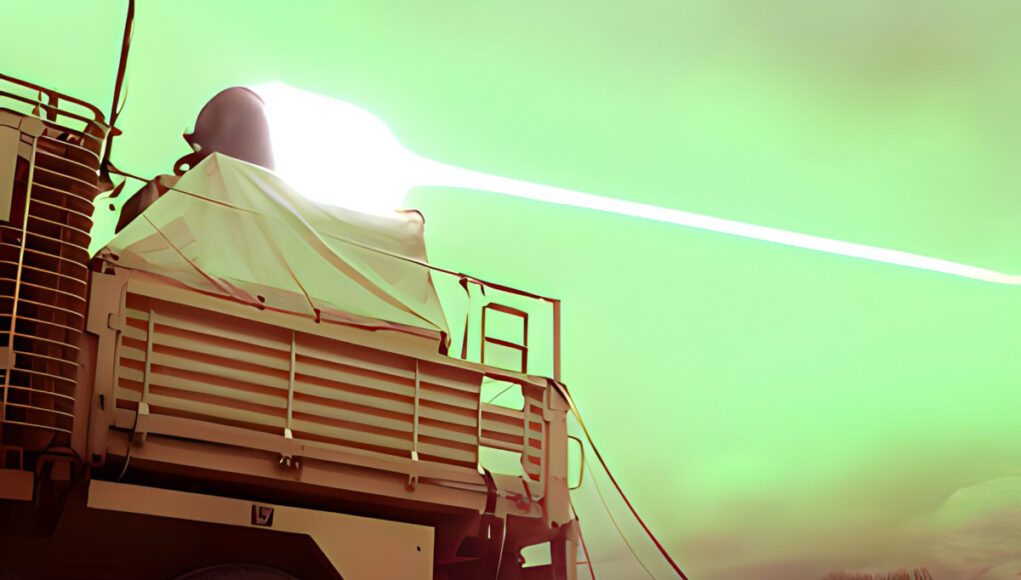
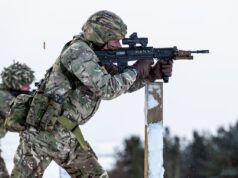
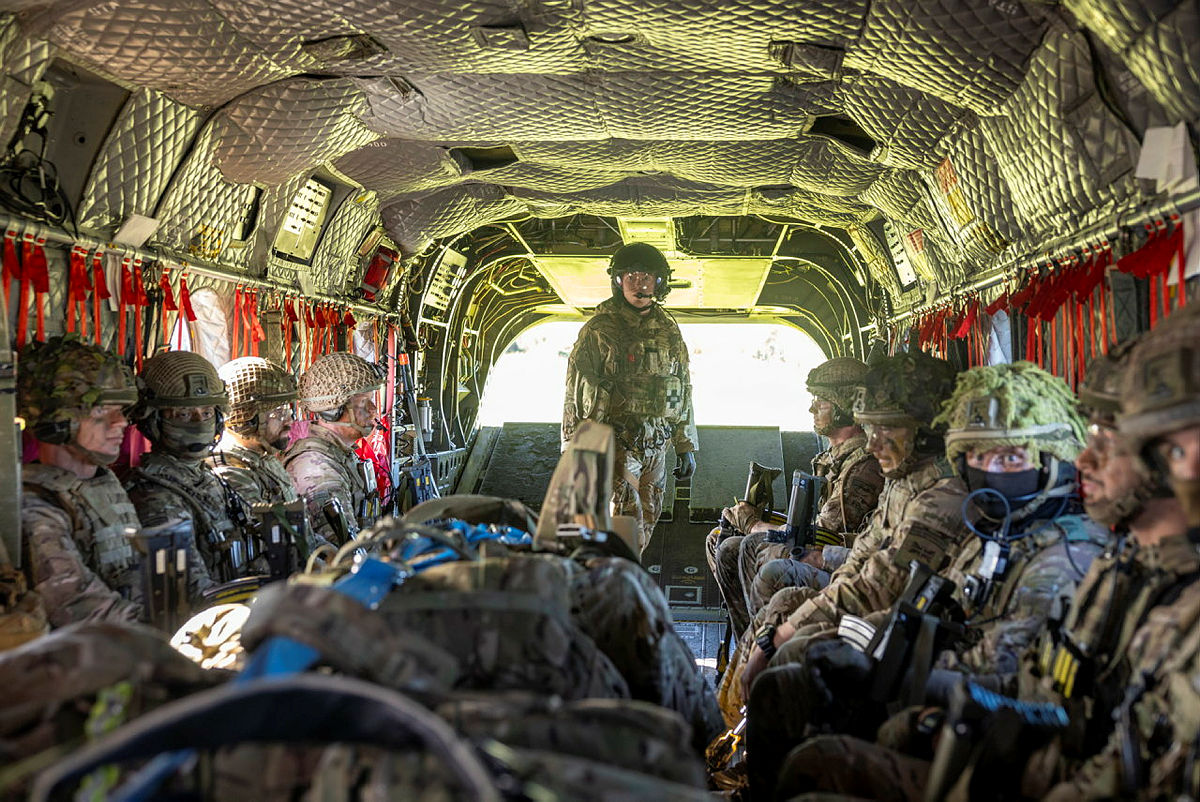
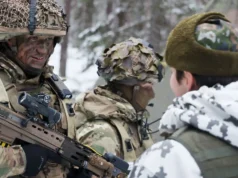
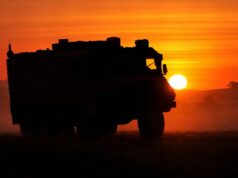

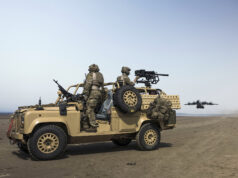

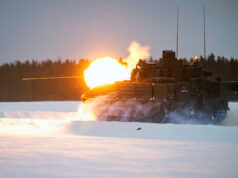



Is this Raytheon’s HELWS 10kw laser that the USAF and US Army have deployed?
Apparently yes. From Raytheon UK “…Laser Weapon System (HELWS) integrated onto a British army combat vehicle, the first test of its kind in the UK”
Yes, according to a press release on PR Newswire.
It is a 15Kw version of this RTX / Raytheon system to be fitted on a Wolfhound according to their Sept.13 2023 press release
The MOD cotracted Raytheon UK in 2021 to do this work on this proven US 2019? laser
WHY so slow?
Wonder if we’ll see this in Ukraine.
Say a whole load of Wolfhounds sat ready to go there at Chetwynd Barracks the other day.
Also could be big export potential here with NATO allies.
Really good stuff, don’t want to minimise the work that’s gone into this.
But Russia is operating a lot of ISR drones that are small enough to get through gaps in coverage and roam around behind the lines, searching for targets of opportunity for tactical ballistic missiles. Just like Ukraine does with ATACMs. Problem is, these drones are operating at the edge of, or just above MANPADS range- which is much higher than the 1000 m that this laser can shoot. But they’re relatively so numerous that a patriot missile is horrifically expensive to take them down. CAMM may well be some of the answer, but lasers are also gonna have to beef up their range.
They only said the range exceeded 1km. It may be a lot more than 1km
They could well be, I don’t discount that.
But, while MBDA and other western manufacturers generally like to underplay their real max speeds, ranges, etc. I would be surprised if they’re claiming only 15-20% of their real max. range.
Like I said, there’s a major place for this tech, even with a 1000 m range- not discounting that, nor the technical achievement of getting it onto a real usable, deployable platform. I merely remain concerned about the middle ground.
This is Gen 1, and not bad to have achieved portability and accurate target acquisition and ‘steering’. Improvements in range can come. Worth pointing out that there are few army direct fire weapons, even the latest ones, with an effective range much above 2-3km, perhaps only the tank cannon and LRATGM?
Shows there’s a place for SPAAGs still
It feels like the military is fully hoping future tech is going to solve the current drone problem. I just hope their crystal ball is accurate and that the eventually procurement of these laser defences doesn’t come after the next war.
I think we will see a mix of old and new tech used to defeat drones, including lasers, cheap kill drones and machine guns/ auto cannon.
Agreed, we just don’t seem to actually be placing any orders on traditional solutions, even though the threat has been proven to be significant.
And shotguns.
Drones can already be defeated, even before laser guns come onto the scene. Iran fired 170 drones (and other kit) at Israel on 13th April – just about all of them were shot down by IDF and allies. In Ukraine both sides have shot down or electronically neutralised drones. The UK is developing specific anti-drone weaponry.
Shooting them down as they go long distances across countries and across ocean is pretty straight forward. Doing the same when they are launched a few hundred meters away is a whole different puzzle to solve.
is related to the dragonfire programme?
What are they going to experiment on exactly?
So, in time do people think this will be useful as a counter missile system, like Gatekeeper was? intercepting incoming IDF’s or eliminating missile threats?
This is an excellent defense capability to develop. When combined with capable EWCM systems, it would make for an excellent assault airdefense cover system as well, specifically for protecting breaching units from FPV drone attacks. However the device is still limited by weather, which means it is limited in tactical application to fair weather oppertunities. For hypersonic weapons defense, reliance on rail guns is prudent for their all-weather capability, but for cost effectiveness, and combat endurance, it is a usefull weapon system, specially if multiple units are mounted on rail cars with massive power generation systems added to increase combat endurance. I would still suggest pairing the system with rail guns for all weather operations and to ensure capability to defend itself in poor weather for tactical withdrawals.
Pew Pew… sorry couldn’t resist it…. its what a decent squaddie would say.
Must be a lot lower power than dragon fire but still useful against drones as instantaneous if given enough power.
A solid well aimed round would do the job just as well and as most drones are slow moving and need killed with something quickly. Also such can be used in other roles too. Would, could this be used against troops, vehicles????? Low tech can win over high tech as it gives MASS
Would those around the firing of these lasers need some substantial eye protection even if tucked away from it as the glare must be absolutely blinding?
I’d imagine you can barely even see it unless someone points it right at you, and in that case I’m not sure some eye pro is going to do the job!
The beam is very “coherent’, tightly packed, that’s what gives a laser it’s power. Outside of the beam there may be a bit of scatter but you’d have to be looking down the beam for it to melt your head right off!🤓
Do we interpret “mounted on a land vehicle” to mean a stationary vehicle? Or can this system hit things while the vehicle is moving?
My god, the advancement in this technology is astounding, to an ignoramus like me. What is military (hardware), going to look like in ten years? It’s like something out of Star Wars and I’m glad that Britain is at the forefront of its development.
That will be a game changer technology has gone to another level great asset to the British Army armoury.i wish I was still serving to see how the British Army has changed since I joined in 1989 and retired 2011 .
Will it still work against targets that have a reflective coating applied to it, or simply wrapped with foil?
OT but still British Army (BA). Saw an article this morning that Ajax IOC is set for Dec 2025. IOC defined as delivery/acceptance of 50 production standard vehs (variant not specified) – 27 to a field unit (said to be about a squadron, but 27 sounds too many for a sqn) and 23 to the Trg Org (RAC and REME).
Isn’t Warrior supposed to be retired from 2025? This looks like leaving us woefully short of the required vehicles.
Can’t keep relying on the eternal Bulldog.
??
Ajax is a recce vehicle and replaces CVR(T) Scimitar. Ajax variants of course replace the other CVR(T)s.
Warrior is an IFV and is being replaced from the middle of this decade (ie from 2025). It is being replaced by Boxer APC. Boxer variants will replace FV430s (ie Bulldog etc).
Required vehicles of all kinds, not just recce.
Boxer build rate is glacial. And both Warrior and Bulldog due to be retired in/from next year.
Yes, fully agree. The MoD seems to be very good at getting rid of vehicles from the inventory (and not just to Ukraine), often before replacements are available in quantity.
They took Scimitar out of service in March 2023, yet Ajax is only to be fielded at 50 vehicles in Dec 2025 (IOC), let alone FOC. So the gap is filled by Warrior redesignated in a recce role, for which extra maintenance funds had to be sought. [I know Scimitar was 50 years old but could the Mk2s not have managed another few years?]
60 AS-90s taken out of service and issued to Ukraine before its successor is fielded (Boxer RCH-155) so something had to fill the gap – 14 second-hand Archers. I suspect many more than 60 AS-90s have been withdrawn from unit service.
There will be an issue as you say in Boxers coming in (slowly) to replace Warrior and Bulldog, which might be retired at pace. Boxer Initial Operational Capability (IOC) is scheduled for 2025, and Full Operational Capability (FOC) in 2032 – so 7 years to field the 623 order. Then there has to be a further one or two tranches to meet the army’s requirement.
They surely are retiring some vehicles too quickly.
Hopefully there is some sense with the new government or they’ll end up with lots of capability gaps.
They either need to build Boxwr much faster or keep Warrior and Bulldog until 2030 realistically.
AS90 is being disposed of by gifing to UKR far too quickly, well before Boxer RCH-155 comes in. The interim capability of a mere 14 Archers is just too few.
James Cartlidge said in Dec 2023 that Warrior would not be fully gone until 2025. No comment on Bulldog. I agree that Boxer needs to be delivered at a much greater rate than just 65 per year.
In faireness, Warrior is operating as a bridge between CVRT and Ajax in the Recce Regiments.
Yes, thats a fair point.
Great…
A torch!